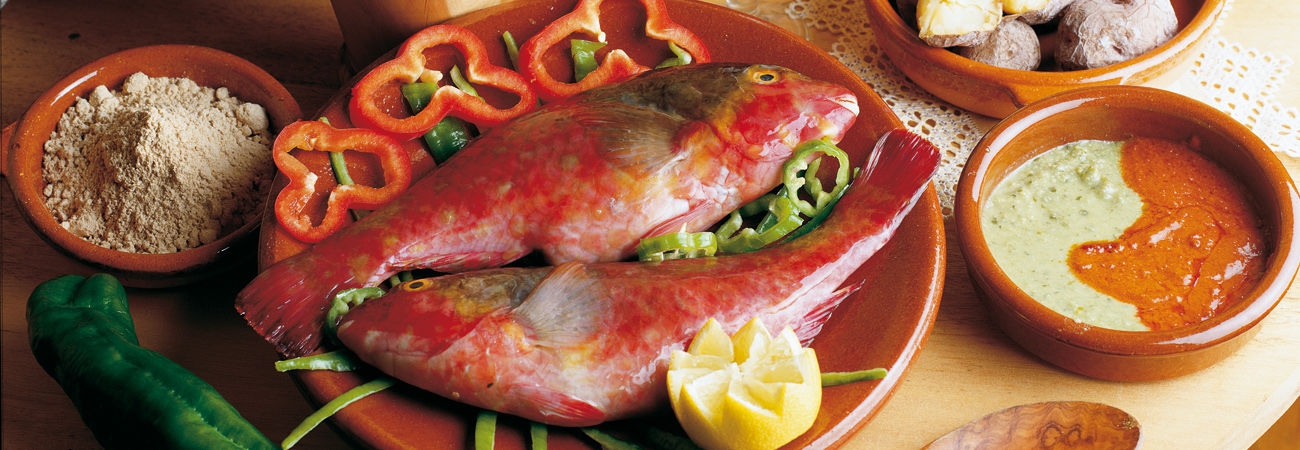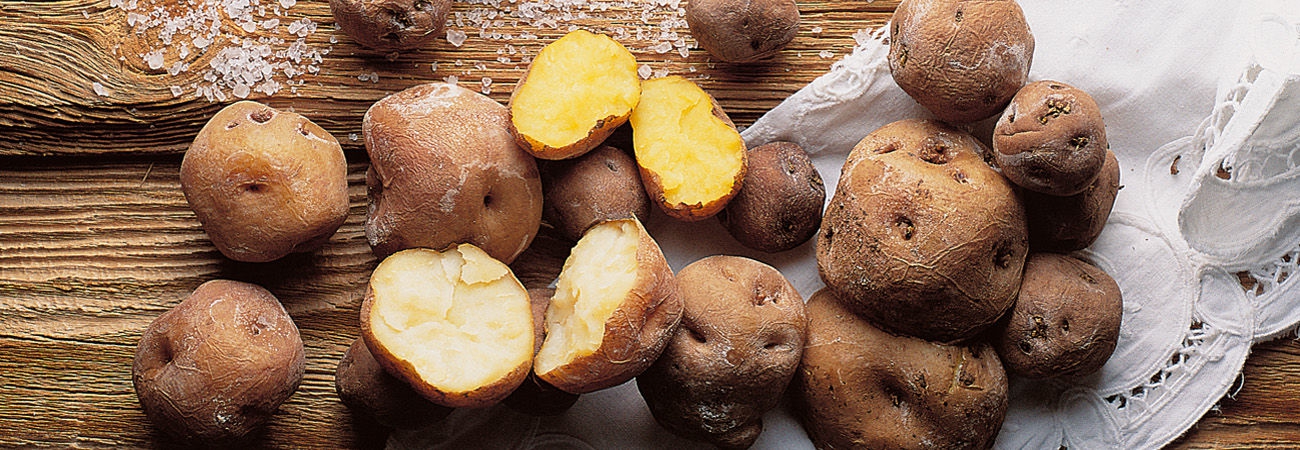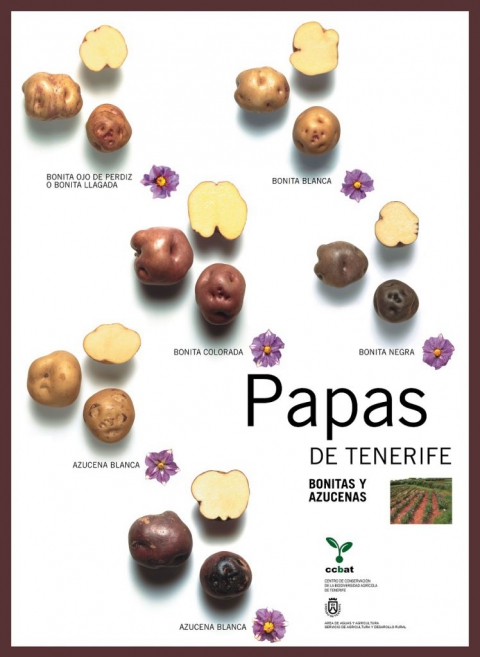Tenerife Potatoes
Introduction
The potato varieties native to Tenerife are a traditional island gastronomic delight, appreciated for their quality and their unique flavours. The inherent climatic characteristics of the Canary Islands have generated an adaptive development process quite distinct from the rest of Europe, where the passage of time has created changes on the morphology of the potato. Contrary to this, the Andigena potatoes introduced in Tenerife at the beginning of the 17th century have maintained their original form, exactly as it was over 7000 years ago in the mountains of Peru and Colombia. The Azucena Negra, the Negra Yema de Huevo, the Papa Bonita in all its varieties, the Torrenta and Borralla are just a few of the many indigenous potato varieties grown in Tenerife. They are in great demand from the most famous gourmets of Spanish luxury food.
Tenerife Potatoes
The papa or potato is a characteristic product of the Canarian cooking tradition and all its varied strata. They are eaten in all the households of the islands and practically everyone likes them.
Their great success lies in their quality, as all the varieties cultivated on the Islands have unique and favoured characteristics to a greater or lesser degree.
The potato originated thousands of years ago in the altiplanos of Perú, Bolivia, Colombia and Chile and, according to some experts, some varieties come from the island of Chiloe, in the south of Chile. They were first brought to the Canary Islands, it seems, when America was discovered by the Europeans, which would not be surprising, as the Archipelago was a compulsory stop-over point on the route between the Old and New Worlds.
Various references indicate that in the year 1567 passing ships brought cargos of tubers to the Islands. In 1776, the historian Viera y Clavijo on the basis of the oral tradition that still remained, wrote that “the first potatoes were brought to Tenerife from Peru by Juan Bautista de Castro, around the year 1622”.
This Juan Bautista de Castro brought with him a miracle, which was to become the basic staple of the Canarian diet, existing side by side for centuries with the chestnut brought by the Galicians, which were an important element of home cooking until the last century,-bearing witness to this was the great number of chestnut trees in the recent past- although nowadays they are hardly used at all.
The original term “papa”, which is still used in the Islands, whereas in mainland Spain, it was mixed, it seems with the Portuguese term “batata”, was one of the early recordings in the Spanish Language included in the communication sent from the Cusco bishop, fray Vicente Valverde, to King Charles I, in 1539, in which, speaking of foods found, he recounts: “… roots, ages, batatas, cauí, which is a root when cooked is like toasted hazelnuts, papas, which is something like ground truffles in Spain…”.
A wide variety of potatoes acclimatized to the Islands, and grew vigorously in vegetable plots that became magnificent gardens, and many were given special names: papas azucenas, azucena negra, bonitas, bonita ojo de perdiz , coloradas, colorada de baga, potatoes de parral, meloneras, moradas, rosadas, blancas, potatoes negras, etc.
“Negras”, including the contemporary variety “negra oro”, are the most expensive in the world. The variety “s. milleferum”, perhaps from the Columbian Andes, although others say they originally came from Peru, adapted particularly well to the volcanic soil in Tenerife and acquired characteristics and flavours here that have given them the status of a high class gastronomical product. A tuber with a blackish blue skin and a golden interior, like the yolk of a hard boiled egg, enhances any dish it accompanies, whether “arrugada” or peeled and boiled. Potato crops extended right across the island. In the lowlands, the plantations formed luminous green carpets, covering a soil which the farmer knew concealed a treasure that loyally sprang forth in each harvest to brighten the Canarian table, a table that could do without lmost anything except the customary papa.
Our high quality potatoes experienced hard times some decades ago, when the importation of high production varieties with fair cooking results predominated, but the surge of a movement vindicating its gastronomical interest has helped to recover crops and prevent the disappearance of varieties that are highly valued both from a culinary and scientific point of view. The papa is an ideal accompaniment to Canarian dishes, for saucy meat dishes, for fresh fish stews, for casseroles and mojos.
Even served on their own, accompanied with an excellent extra virgin olive oil, fresh butter, and in recent times, with a “caviar gomero”, or haute cuisine sauces like “hollandaise” or “béarnaise”, they make for a culinary delight.
If, as related by the Venezuelan Arturo Uslar Pietri, the first Europeans on their arrival in America lamented the sorry state of affairs whereby they were reduced to “eating roots”, they soon discovered that these roots, in the case of potatoes, were a nice food. Centuries have passed since the papa was first brought to the Islands and if they were in former times Andean, now they are decidedly Canarian. Hearty or delicate, large or small, yellow or white, grown in the soil of the north or south of Tenerife, they now form an integral part of our culinary tradition.
Papa Canaria (Protected Designation of Origin PDO)
It is the first PDO obtained in Spain for this tuber and the second in Europe. Protected Designation of Origin (PDO) is the highest recognition granted by the European Union (EU) to agri-food products of differentiated quality.
The climatic and edaphic conditions of the Canary Islands, especially Tenerife, make local potato production acquire different characteristics and quality, highly appreciated for the excellence of its qualities and flavor.
For decades, there were many who defended the uniqueness and genetic richness that these varieties of potatoes contain. Requested by the producers in March 2009 and granted, finally, in October 2013, after four years of processing, the Protected Designation of Origin (PDO) Papas Antiguas de Canarias, is already a fact, which protects a total of 29 varieties.









